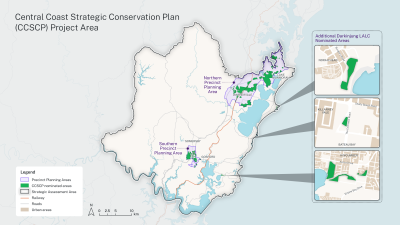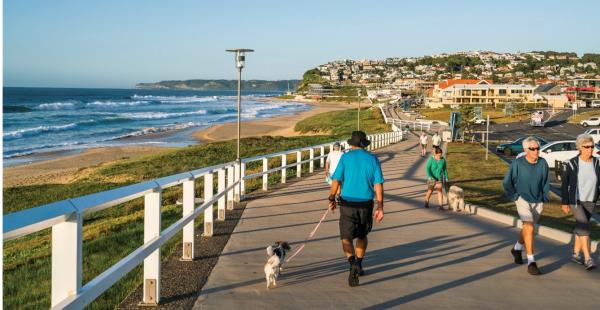We are making a plan for the Central Coast that creates more land for jobs and homes and protects native plants and animals.
The plan will identify where development can happen and areas that need to be protected. It aims to balance development and biodiversity on the Central Coast.
Around 3,069 hectares of land will be included in the plan. The plan is aligned to the priorities in the Central Coast Regional Plan 2041, and includes land owned by Darkinjung Local Aboriginal Land Council. The NSW Government and the Commonwealth Government have entered into an agreement to progress the plan.
We have exhibited the first stage of the plan - draft terms of reference - under section 146(1B)(b)(ii) of the Commonwealth Environment Protection and Biodiversity Conservation Act 1999. It set out how the impacts of development on biodiversity protected under the Act are assessed.
The draft terms of reference did not include details of the plan or information on individual landowner property mapping. Feedback from the exhibition will inform the strategic assessment report.
The draft terms of reference were on exhibition for public feedback 15 November 2024 – 10 January 2025. The draft Central Coast Strategic Conservation Plan and strategic assessment report will be exhibited for public feedback in 2025. The public exhibition of these documents will be the formal opportunity for you to comment on the plan.
The final plan will then be submitted for approval by both State and Commonwealth Governments.
For more information email [email protected]
View the draft Terms of Reference for Central Coast strategic assessment
Frequently asked questions
Frequently asked questions
What is the purpose of the Central Coast Strategic Conservation Plan?
What is the purpose of the Central Coast Strategic Conservation Plan?
The plan will seek biodiversity approvals for the development of land. This will be in line with state and federal legislation. These approvals will allow development to happen on land that does not have high biodiversity value. Land can be developed without the need for individual site assessments for biodiversity.
Land covered by the conservation plan has been identified for growth under the Central Coast Regional Plan 2041 and the Darkinjung Local Aboriginal Land Council’s development delivery plan.
Why is a conservation plan needed?
Why is a conservation plan needed?
A conservation plan is needed to support the Central Coast region’s development. The Central Coast Strategy for Economic Growth has identified the need for the plan. The plan will contribute to the NSW Government’s housing priorities and targets. It will also contribute to healthier communities and environments. It supports the objectives of the Central Coast Regional Plan 2041.
Rather than site-by-site approvals, the conservation plan will look at biodiversity approvals at a broader, landscape scale. It looks at the cumulative impacts of growth to protect and manage the area’s biodiversity over the long term.
What areas does the conservation plan cover?
What areas does the conservation plan cover?
Land within the Greater Warnervale, Greater Lake Munmorah and Somersby growth areas and precincts, as identified in the Central Coast Regional Plan 2041. It also includes several sites owned by Darkinjung Local Aboriginal Land Council.

What are the next steps in developing the conservation plan?
What are the next steps in developing the conservation plan?
Publicly exhibiting the draft terms of reference under the Environment Protection and Biodiversity Conservation Act 1999 is an important step in developing the plan.
Once the draft terms of reference are finalised, we will complete the draft strategic assessment report and draft Central Coast Strategic Conservation Plan. We will publicly exhibit these for feedback in 2025.
The draft plan will identify land where development is suitable. It will also identify areas of high biodiversity value where development must be avoided. The plan will outline a conservation program to balance the impacts of growth.
Your feedback on the draft documents is important. All feedback will be considered before the final plan is submitted to the state and federal environment ministers for consideration and approval.
We pay respect to the Traditional Custodians and First Peoples of NSW and acknowledge their continued connection to their country and culture.

